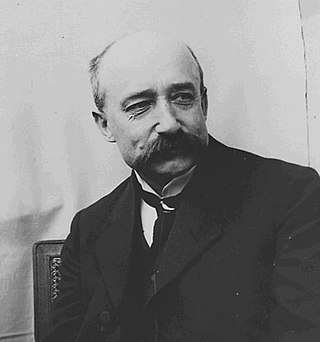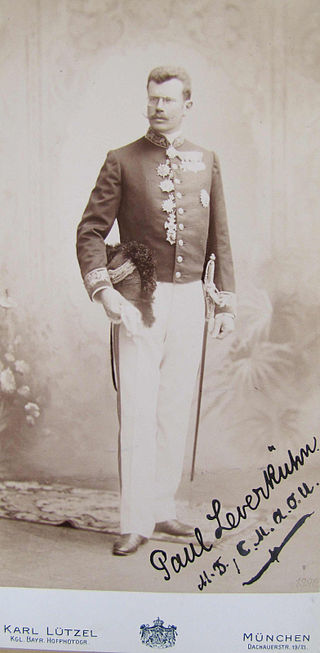Related Research Articles

Ornithology is a branch of zoology that concerns the study of birds. Several aspects of ornithology differ from related disciplines, due partly to the high visibility and the aesthetic appeal of birds. It has also been an area with a large contribution made by amateurs in terms of time, resources, and financial support. Studies on birds have helped develop key concepts in biology including evolution, behaviour and ecology such as the definition of species, the process of speciation, instinct, learning, ecological niches, guilds, island biogeography, phylogeography, and conservation.

Erwin Friedrich Theodor Stresemann was a German naturalist and ornithologist. Stresemann was an ornithologist of extensive breadth who compiled one of the first and most comprehensive accounts of avian biology of its time as part of the Handbuch der Zoologie. In the process of his studies on birds, he also produced one of the most extensive historical accounts on the development of the science of ornithology. He influenced numerous ornithologists around him and oversaw the development of ornithology in Germany as editor of the Journal für Ornithologie. He also took an interest in poetry, philosophy and linguistics. He published a monograph on the Paulohi language based on studies made during his ornithological expedition to the Indonesian island.

Sálim Moizuddin Abdul Ali was an Indian ornithologist and naturalist. Sometimes referred to as the "Birdman of India", Salim Ali was the first Indian to conduct systematic bird surveys across India and wrote several bird books that popularized ornithology in India. He became a key figure behind the Bombay Natural History Society after 1947 and used his personal influence to garner government support for the organisation, create the Bharatpur bird sanctuary and prevent the destruction of what is now the Silent Valley National Park.
Drost is a Dutch occupational surname. A drost or drossaard was a kind of bailiff in the Low countries. Notable people with the surname include:

Hans Friedrich Gadow was a German-born ornithologist who worked in Britain. His work on the classification of birds based on anatomical and morphological characters was influential and made use of by Alexander Wetmore in his classification of North American birds.

Witmer Stone was an American ornithologist, botanist, and mammalogist, and was considered one of the last of the “great naturalists.” Stone is remembered principally as an ornithologist. He was president of the American Ornithologists’ Union (AOU) 1920–23, and was editor of the AOU's periodical The Auk 1912–1936. He spearheaded the production of the 4th edition of the AOU checklist, published in 1931. He worked for over 50 years in the Ornithology Department at the Academy of Natural Sciences of Philadelphia, eventually serving as Director of the institution. Stone was one of the founding members of the Delaware Valley Ornithological Club (DVOC) in 1890 and was actively involved in the organization for the remainder of his life. Stone was one of only two scientists to serve as president of both the AOU and the American Society of Mammalogists, and he co-authored two popular books about mammals. His outstanding botanical contribution was The Plants of Southern New Jersey, published in 1911. Stone spent many summers at Cape May, New Jersey, summering there annually starting in 1916. He is best remembered for his two-volume classic Bird Studies at Old Cape May, which was published by the DVOC in 1937, two years before his death.

Heinrich Gätke was a German ornithologist and artist.
George Waterston OBE FRSE FZS LLD was a 20th-century Scottish stationer, ornithologist and conservationist. From 1949 to 1954 he owned the remote Scottish island, Fair Isle.

The Heligoland Bird Observatory, one of the world's first ornithological observatories, is operated by the Ornithologische Arbeitsgemeinschaft Helgoland e.V., a non-profit organization which was founded in 1891 to support research on the fauna of Heligoland, a small German archipelago, comprising the islands of Heligoland and Düne, in the Heligoland Bight of the North Sea. The principal research focus is on bird migration through banding studies. Over 400 species have been recorded. OAG Helgoland produces an annual bird report.

Max Hugo Weigold was a German zoologist and a pioneer bird bander who worked at the Heligoland Bird Observatory, one of the world's first bird-ringing sites.

Johannes Thienemann was a German ornithologist and pastor who established the Rossitten Bird Observatory, the world's first dedicated bird ringing station where he conducted research and popularized bird study.

The Rossitten Bird Observatory was the world's first ornithological observatory. It was sited at Rossitten, East Prussia, on the Curonian Spit on the south-eastern coast of the Baltic Sea. It was established by German ornithologist Johannes Thienemann and operated until 1944. In 1945 East Prussia was divided between Poland, Russia and Lithuania, and most ethnic Germans expelled.

Viktor von Tschusi zu Schmidhoffen was an Austrian ornithologist.
Leon Jacob Cole was an American geneticist and ornithologist.

Paul Georg Heinrich Martin Reinhold Leverkühn was a German physician and ornithologist.

Rudolf Heinrich Paul Blasius was a German physician, bacteriologist, naturalist and ornithologist.
Hans Egon Wilhelm Schildmacher was a German zoologist who specialized in ornithology particularly on avian physiology and endocrinology. He served as a professor of zoology at the University of Greifswald.
Alfred Schifferli was a Swiss ornithologist who established bird ringing in Switzerland at the Schweizerische Vogelwarte Sempach which was begun by his namesake father and published the first breeding bird atlas of Switzerland in 1980. He also founded the Swiss League for the Protection of Nature.

Ernst Paul Theodor Schüz was a German ornithologist and a curator at the natural history museum in Stuttgart. He was known for his extensive work at the Rossiten bird observatory, particularly for his studies on white storks.
Ernst Sutter was a Swiss ornithologist and curator at the Basel museum. Sutter was a pioneer of radar ornithology, the study of bird migration using radar, in Europe.
References
- ↑ "Rudolf Drost 1892-1971". Ibis. 115: 141. 2008. doi: 10.1111/j.1474-919X.1973.tb02633.x .
- ↑ Goethe, F. (1972). "Rudolf Drost 1892–1971". Journal of Ornithology. 113 (2): 219–224. doi:10.1007/BF01640505. S2CID 21579953.